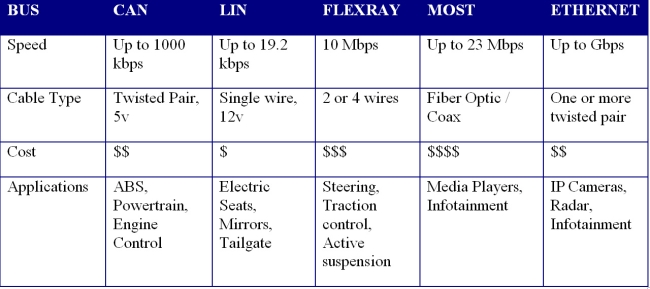Since its inception in 2003, the AUTOSAR (Automotive Open Systems Architecture) Alliance has been working to change the way in-vehicle networks and electronic control units (ECUs) are designed. AUTOSAR proposes an industry-standard in-vehicle network design methodology that enables the industry to integrate, exchange and transmit functions, data and information within the automotive network. This standard greatly facilitates collaboration between automotive original equipment manufacturers (OEMs) and their Tier 1 suppliers, enabling them to exchange design information in a consistent, clear and machine-readable format.
Different parts of a car have different requirements for safety and performance, and the in-vehicle network that supports them must have predictable safety. As automotive technology continues to evolve, a range of bus technologies are available to connect up to 100 different ECUs in luxury cars. These bus technologies typically include LIN, CAN, FlexRay, MOST, and Ethernet-based architectures. If it is impossible to manually manage thousands of information and interactions between these ECUs, automotive designers must use automated design and synthesis tools to predict network performance and adjust vehicle functionality.
Car data bus
A typical modern car will be equipped with various buses and protocols and select the right network from LIN, CAN, FlexRay, MOST and Ethernet. Multimedia/audio-visual signals and automotive surround camera systems require higher data rates, so car manufacturers and OEMs choose to replace MOST with Ethernet on network solutions. But for many standard automotive functions, the bandwidth provided by LIN and CAN And performance is enough.
In the automotive architecture, the ECUs are grouped together to form a "cluster" that is connected by a communication "gateway." Clusters usually share the same type of bus, so to achieve high reliability, high rate standards, FlexRay network is required, but the door lock ECU that requires less high can be responsible for CAN or LIN. ECU gateways often have to connect different types of signals and perform mapping and conversion functions between different bus architectures. The automotive industry places strong demands on increasing safety and compliance with standards such as ISO26262, which in turn improves the performance of in-vehicle networks while reducing manufacturing and component costs. Evolving network standards can adapt to ever-increasing data rates, and automotive cables have reached a safe and low-cost goal. The characteristics and applications of typical automotive network solutions are shown in Table 1.

Table 1: Automotive network bus.
FlexRay network:
The FlexRay protocol is more deterministic than CAN. FlexRay is a "time-triggered" protocol that offers different options for information to be sent to the target address in a precise time frame - accurate to 1μs. FlexRay information can be up to 254 bytes, so it needs to be in the ECU The amount of complex information exchanged between them is large. Compared to CAN, FlexRay has a higher data transfer rate. Since the timing is predetermined, the information needs to be planned in advance and is generally pre-configured or designed by the automotive OEM or Tier 1 supplier partner. In a network using the CAN protocol, the ECU node only needs to know the correct baud rate when communicating, but the ECU node on the FlexRay network must know how the various parts of the network are configured and connected when communicating. Checking and verifying the timing of the FlexRay network is time consuming – so automated timing analysis and packetization of information into time frames can reduce errors and design cycle times.
Automotive communication matrix synthesis
The overall definition of automotive network scheduling is typically stored in a "communication matrix" that is part of the central gateway ECU. The design tool solution developed by Mentor can be used to automatically synthesize this database and package all the different information into frames in the correct order.
The AUTOSAR signal information is combined into Protocol Data Units (PDUs) which are then combined into a transmission frame. For CAN and LIN frames, there is one PDU per frame, but one FlexRay frame may contain multiple signal PDUs.
In the FlexRay architecture, timing is deterministic, and the main uncertainty facing designers is frame packing and transmission order. Automotive OEMs and designers invest a lot of time in testing all possible situations in a car to determine worst-case behavior and ensure a greater safety margin for information transmission. This means that in order to ensure a high level of timing safety, the full capacity of the data bus cannot be taken up. The synthesis tool optimizes frame utilization by finding signals with similar paths and timing requirements for packing and scheduling in similar frame time gaps. When using Mentor's timing synthesis tool, the design inputs will include signal and PDU definitions, frame priority, and specific OEM design decisions regarding possible signal paths. Take these into account when generating a complete timing system.
There is a problem in installing a fully defined communication system, that is, it is difficult to have architectural changes in the future, and may require a complete redesign of the network, but the advantages of high speed and certainty of transmission make this method to FlexRay. The application creates great appeal and ensures the car's very high safety requirements. Re-establishing a more advanced communication system with this synthesis tool can shorten the repair cycle.

Memory For Mini PC And Desktop
Shenzhen Innovative Cloud Computer Co., Ltd. , https://www.xcycomputer.com